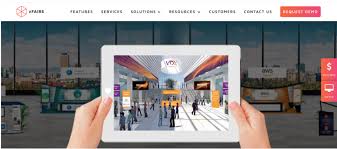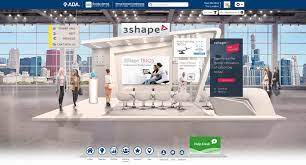The Rise of Virtual Booth Platforms in the Event Industry
With the increasing shift towards virtual events, the use of virtual booth platforms has become more prevalent in the event industry. These platforms offer a unique and interactive way for businesses to showcase their products and services in a virtual environment.
Virtual booth platforms provide a range of features that mimic the experience of attending a physical event. From customizable booth designs to interactive elements such as live chat, video presentations, and downloadable resources, these platforms offer a comprehensive solution for exhibitors looking to engage with attendees online.
One of the key advantages of virtual booth platforms is their ability to reach a global audience without the need for physical travel. This not only reduces costs for exhibitors but also increases accessibility for attendees who may not have been able to attend an in-person event.
Furthermore, virtual booth platforms offer valuable data analytics that can help exhibitors track visitor engagement, measure ROI, and gather insights for future marketing strategies. This data-driven approach allows businesses to optimize their virtual booth experience and improve their overall event performance.
In conclusion, the rise of virtual booth platforms signifies a significant shift in how events are conducted in today’s digital age. As technology continues to evolve, these platforms will play an increasingly important role in connecting businesses with their target audience and creating memorable online experiences.
8 Advantages of Virtual Booth Platforms: Expanding Reach, Cutting Costs, and Boosting Engagement
- Global reach without physical travel
- Cost-effective compared to traditional booths
- Interactive features enhance attendee engagement
- Customizable booth designs for branding consistency
- Real-time data analytics for performance tracking
- Increased accessibility for remote attendees
- Environmentally friendly alternative to physical events
- Opportunity for extended networking and lead generation
Five Drawbacks of Virtual Booth Platforms: Navigating Interaction, Technical, and Engagement Hurdles
- Limited physical interaction with attendees
- Potential technical issues or glitches during virtual events
- Difficulty in creating a personalized and immersive experience compared to physical booths
- Challenges in capturing the attention of attendees in a crowded virtual environment
- Lack of tactile product interaction for showcasing physical products
Global reach without physical travel
Virtual booth platforms offer the distinct advantage of enabling businesses to achieve a global reach without the constraints of physical travel. By participating in virtual events through these platforms, exhibitors can connect with a diverse audience from around the world, expanding their reach and potential customer base without incurring the costs and logistical challenges associated with traditional in-person events. This accessibility not only enhances brand visibility on a global scale but also fosters meaningful interactions with attendees regardless of their geographic location, ultimately driving business growth and opportunities in a borderless digital landscape.
Cost-effective compared to traditional booths
Virtual booth platforms offer a significant advantage in terms of cost-effectiveness compared to traditional booths. By eliminating the need for physical materials, transportation, and on-site staff, virtual booths can drastically reduce expenses for exhibitors. This cost-saving benefit allows businesses to allocate their budget more efficiently, reach a wider audience, and maximize their return on investment in virtual events.
Interactive features enhance attendee engagement
The interactive features of virtual booth platforms significantly enhance attendee engagement by providing a dynamic and immersive experience. From live chat capabilities to virtual product demonstrations and interactive games, these features captivate attendees’ attention and encourage active participation. By fostering real-time interactions between exhibitors and attendees, virtual booth platforms create a more personalized and engaging environment that promotes meaningful connections and drives increased interest in the showcased products or services.
Customizable booth designs for branding consistency
Virtual booth platforms offer a valuable pro by providing customizable booth designs that enable businesses to maintain branding consistency across their virtual presence. By tailoring the visual elements of their virtual booths to align with their brand identity, companies can create a cohesive and immersive experience for attendees. This level of customization not only reinforces brand recognition but also helps establish a strong brand image that resonates with visitors, ultimately enhancing engagement and leaving a lasting impression.
Real-time data analytics for performance tracking
Virtual booth platforms offer a significant advantage through their provision of real-time data analytics for performance tracking. This feature allows exhibitors to monitor visitor engagement, measure the effectiveness of their virtual booth, and gather valuable insights instantly. By leveraging this data-driven approach, businesses can make informed decisions to optimize their virtual booth experience, enhance attendee interactions, and ultimately improve their overall event performance.
Increased accessibility for remote attendees
Virtual booth platforms offer a significant advantage by increasing accessibility for remote attendees. By eliminating the need for physical travel, these platforms enable individuals from around the world to participate in events and engage with exhibitors without any geographical constraints. This enhanced accessibility not only expands the reach of events but also provides an inclusive environment for remote attendees to connect with businesses, access valuable information, and network with industry professionals, ultimately enhancing the overall event experience for all participants.
Environmentally friendly alternative to physical events
Virtual booth platforms offer an environmentally friendly alternative to physical events by significantly reducing the carbon footprint associated with traditional in-person gatherings. By eliminating the need for attendees and exhibitors to travel to a physical location, virtual booth platforms help decrease greenhouse gas emissions from transportation and energy consumption. This eco-conscious approach not only contributes to sustainability efforts but also promotes a greener future for the event industry as a whole.
Opportunity for extended networking and lead generation
Virtual booth platforms offer a valuable opportunity for extended networking and lead generation. By providing interactive features such as live chat, virtual meetings, and contact exchange capabilities, exhibitors can engage with attendees beyond the confines of a physical event. This extended networking potential allows businesses to connect with a larger audience, nurture relationships with prospects, and generate leads in a dynamic and efficient manner. The ability to continue conversations post-event and follow up on leads effectively enhances the overall networking experience and maximizes the potential for business growth.
Limited physical interaction with attendees
One significant drawback of virtual booth platforms is the limited physical interaction with attendees. Unlike traditional in-person events where exhibitors can engage with visitors face-to-face, virtual booths rely on digital communication channels such as chat features and video calls. This lack of physical presence can hinder the personal connection and spontaneity that often come with in-person interactions, making it challenging for exhibitors to establish a strong rapport and build trust with attendees. Additionally, the absence of physical touchpoints may result in a less immersive and memorable experience for both exhibitors and visitors.
Potential technical issues or glitches during virtual events
One significant drawback of virtual booth platforms is the potential for technical issues or glitches to occur during virtual events. These technical hiccups, such as poor internet connection, audio/video lag, or platform crashes, can disrupt the attendee experience and hinder communication between exhibitors and visitors. As a result, these issues may lead to frustration among participants and impact the overall success of the event. Organizers and exhibitors must be prepared to troubleshoot technical problems swiftly to minimize disruptions and ensure a seamless virtual event experience for all involved.
Difficulty in creating a personalized and immersive experience compared to physical booths
One notable con of virtual booth platforms is the challenge of creating a personalized and immersive experience that rivals the engagement level of physical booths. While virtual platforms offer various interactive features, such as live chat and video presentations, replicating the tangible and sensory experience of a physical booth can be difficult. The lack of face-to-face interactions, hands-on product demonstrations, and the ambiance of a physical space can hinder the ability to fully immerse attendees in the brand experience, potentially impacting the depth of engagement and connection that can be achieved virtually.
Challenges in capturing the attention of attendees in a crowded virtual environment
One significant challenge of virtual booth platforms is the difficulty in capturing the attention of attendees in a crowded virtual environment. With numerous exhibitors vying for attention, it can be challenging for businesses to stand out and engage effectively with potential customers. The lack of face-to-face interaction and physical presence makes it harder to draw attendees to a specific booth, leading to increased competition for visibility and engagement. Exhibitors must find innovative ways to differentiate their virtual booths and attract attendees amidst the sea of online distractions, emphasizing the importance of creativity and strategic marketing tactics in navigating this challenge.
Lack of tactile product interaction for showcasing physical products
One notable con of virtual booth platforms is the lack of tactile product interaction for showcasing physical products. In a virtual setting, attendees are unable to physically touch, feel, or interact with products in the same way they would at a traditional in-person event. This limitation can diminish the overall sensory experience and may hinder potential customers from fully engaging with the product, leading to a potential decrease in interest or understanding of its features and benefits.


